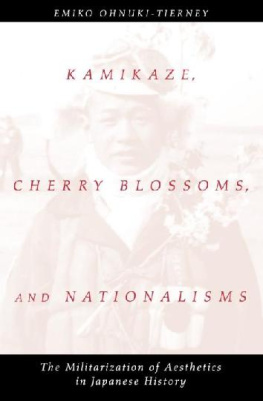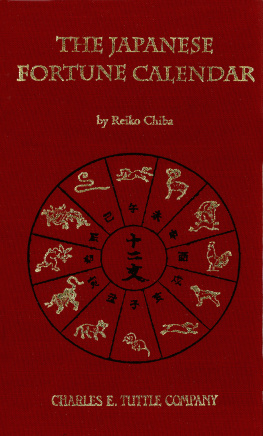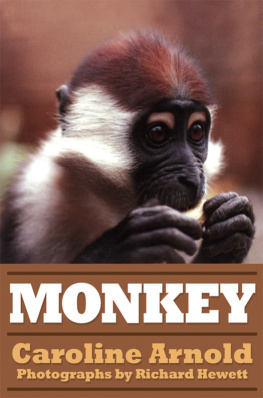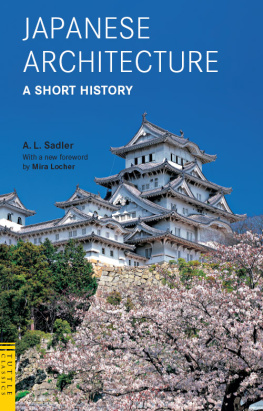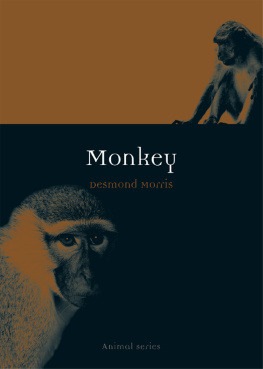Copyright 1987 by Princeton University Press
Published by Princeton University Press, 41 William Street,
Princeton, New Jersey 08540
In the United Kingdom: Princeton University Press,
Chichester, West Sussex
All Rights Reserved
Library of Congress Cataloging-in-Publication Data
Ohnuki-Tierney, Emiko.
The monkey as mirror.
Bibliography: p.
Includes index
1. JapanCivilization. 2. MonkeysJapan
Social aspects. 3. Animals and civilization
Japan. 4. Buraku people. I. Title.
DS821. 03627 1987 306'.0952 87-45530
ISBN 0-691-09434-9
First Princeton Paperback printing, 1989
ISBN 0-691-02846-X
eISBN 978-0-691-22210-3
R0
Preface
NO OTHER WORK have I enjoyed more than that done for this book. In part this was because the monkey symbolism and monkey performances were, to use an American colloquialism, a lot of fun. Also, it was because the book began and ended as the fruit of collegiality: many of my colleagues patiently listened to my talks, read parts or all of the manuscript at various stages of its development, and generously offered their insights.
My thanks are first to Mr. Murasaki Yoshimasa, Mr. Murasaki Shji, Mr. Murasaki Tar, and other contemporary monkey trainers, their friends, and their families, all of whom generously opened the door for me. As detailed in , not only did they let me observe their training sessions and actual performances, they were most generous in sharing their experiences, information, and photographs with me. I cherish the many hours during which we discussed their interpretation and my interpretation of the meaning of the monkey performance. I am particularly grateful to Ms. Kumi Kobayashi of Su Sarumawashinokai, who has kept me in touch with their activities by mail. She also obtained archival materials not available in the United States.
The final stage of manuscript writing was undertaken during the 19851986 academic year with a fellowship from the John Simon Guggenheim Foundation, and during the fall of 1986 at the Institute for Advanced Study, Princeton, under a grant from the National Endowment for the Humanities. My research in its early stages was supported by the Institute for Research in the Humanities at the University of Wisconsin and by the Graduate School, University of Wisconsin, Madison. My fieldwork was supported by the Wenner Gren Foundation for Anthropological Research. I gratefully acknowledge these institutions for their generous support. While the major part of my archival research was done at many archives in Japan, library grants from the Asian Library of the University of Michigan and from the Far Eastern Library of the University of Chicago supported me in the final stage of my archival work. I am indebted to them for their assistance.
This project began as a fortunate accident. In 1981, while I was conducting fieldwork on illness perception and health care in Japan, I had the opportunity to observe the then recently revived monkey performances in Hikari City, Yamaguchi Prefecture. Although I was fascinated by them, I had never seriously considered such performances as a topic of research. In 1982, Professor E. Bruner invited me to present a paper in his plenary session of the American Ethnological Society, which was to meet in Baton Rouge, Louisiana, in 1983. The session was intriguingly entitled Text, Play, and Story: The Construction and Reconstruction of Self and Society. The invitation was too attractive to refuse, and I started the monkey performance projectthe only play I had some data on. So began my struggle and my fun. I thank Professor Thomas Sebeok, who was instrumental in bringing about my initial encounter with the monkey performance, and Professor Bruner for his invitation.
It is embarrassing to list all the talks I gave on different aspects and stages of this research. The first was at the 1983 American Ethnological Society meeting. Other talks were given at the Third Decennial Conference of the Association of Social Anthropologists, Robinson College, Cambridge University; the Wenner Gren Conference on Symbolism Through Time; the departments of Anthropology and East Asian Programs at the University of Chicago; the University of Illinois, Chicago Circle; the University of Tokyo; the University of Michigan; the Institute of Social Anthropology, Oxford University; University College, London; the Nissan Institute of Japanese Studies, Oxford University; the University of Iowa; and the University of Rochester. I thank my colleagues who arranged these talks and those who patiently suffered through them, asking probing questions and offering suggestions.
Professor J. Vansina, who has quietly insisted on the diachronic dimension of culture, has been most influential in the writing of this book. He read the entire manuscript more than once and offered his usual profound insights and criticism. Several others served as readers for publishers, including Professors A. Appadurai, J. Fernandez, J. Peacock, and H. Ooms, and their constructive criticisms were most helpful to me as I revised the manuscript. Professor T. Najita shared with me his knowledge of social mobility in Tokugawa, Japan. Professor D. Greenwood encouraged me to see the relevance of this work to minority groups in general, and Professor Y. Tuan read some chapters and offered useful comments. Professor H. Kawakatsu prompted me to think more carefully about the relationship between the special status people and the professionals (). Dr. A. Waswo offered useful comments on the section on Japanese history. Professor E. Swanger shared with me information on the medical use of the monkey. Professor T. Umesao offered insightful remarks on Japanese ethologists attitude toward macaques. Professors N. Miyata, M. Itoh, and T. Moriya all helped me in locating historical sources, while Professor M. Yamaguchi provided me with provocative suggestions during the initial stage of this project. Professor S. Kita offered his brilliant insights and also helped me to locate Japanese paintings with monkeys. The staff members at the Monkey Center in Inuyama, Nagoya, kindly shared their knowledge; Mr. T. take, in particular, not only shared with me his own long-term study of the monkey in Japanese culture but also sent me a number of photographs of monkeys found in various artifacts housed in the museum of the Monkey Center. Mr. D. Krupa exercised his editorial skill on the manuscript, Ms. T. Kishima helped me in numerous ways in the early stages of research, and Mr. K. Yano assisted me in the final checking of the references.
If I have been fortunate in receiving feedback from my colleagues, I have also been most lucky in receiving professional advice and criticism from various editors. I thank Mr. Peter Agree for his interest in my work as a historian. Ms. Sue Allen-Mills read not only the final version of this book but also a preliminary version almost a year ago, and she offered me invaluable suggestions. Above all, I am most grateful to Mr. Walter Lippincott, Jr., for his warm encouragement and sustained interest in my work over the years, and to Ms. Margaret Case, for her expertise as a historian and editor. Ms. Janet Stern did an admirable job of editing the manuscript, and I thank her for it.


